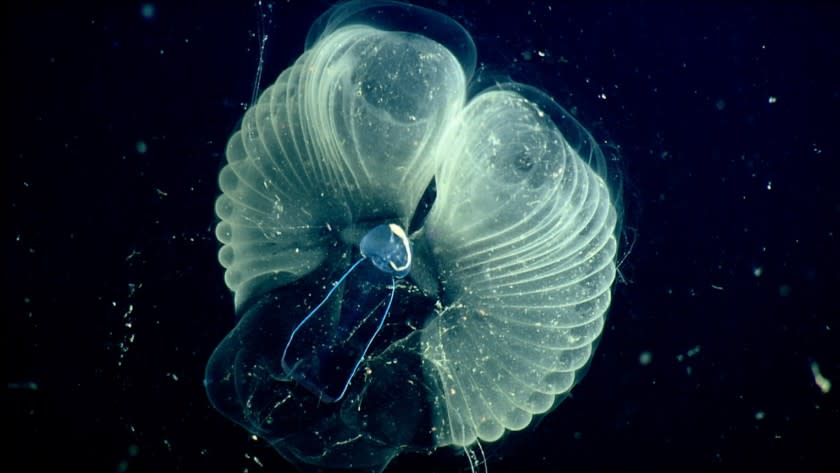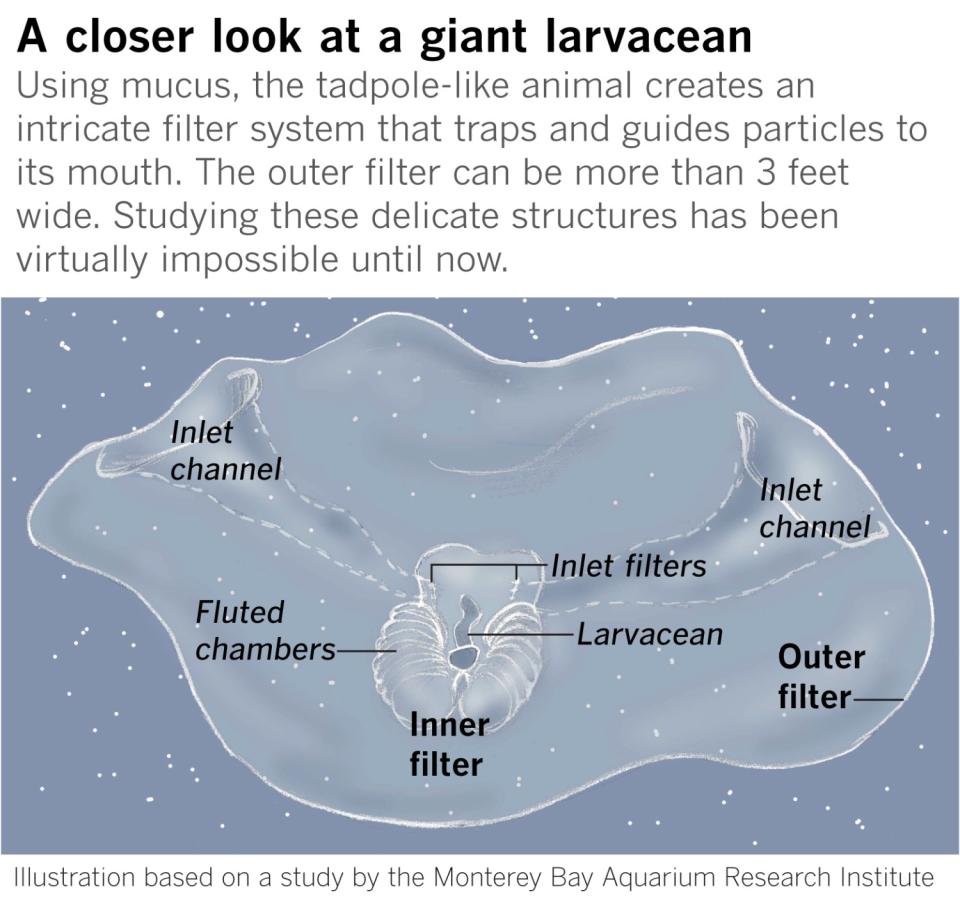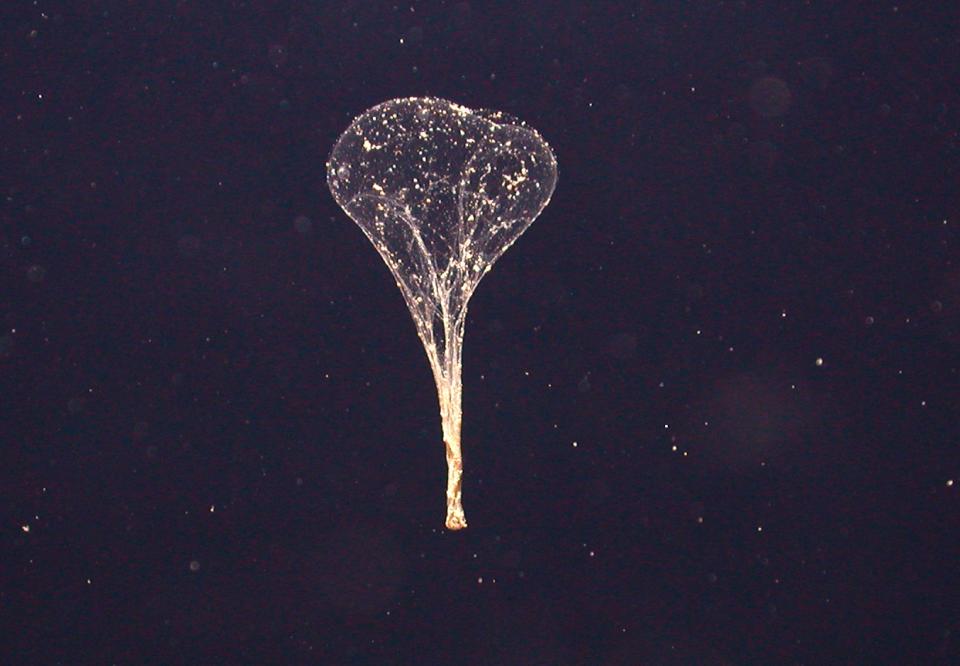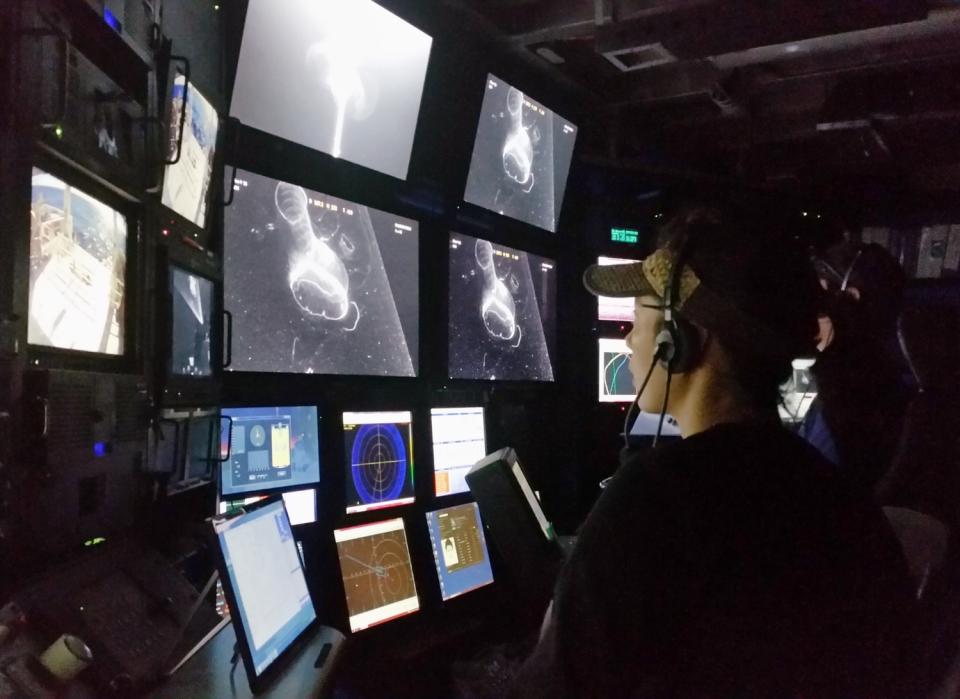This fantastical sea creature helps remove planet-warming gases from the atmosphere

It was decades ago when Bruce Robison first looked through the plexiglass sphere of a submersible and spotted a most curious critter in the waters off Central California.
Nearly transparent and no larger than a fist, the squishy tadpole-like animal was surrounded by an enormous balloon of mucus about 3 feet wide. Robison could discern chambers intricately inflated within this sticky structure, speckled with particles of food and plant debris.
Robison spent years in the open ocean studying these gelatinous animals, which are too large and too fragile to bring back into a lab. Known as giant larvaceans, they inhabit seas across the world. Tens of thousands of them live just outside Robison's office in Monterey Bay.
He and fellow researchers eventually learned that these creatures and their snot palaces play an outsize role in helping the ocean remove planet-warming carbon dioxide from the atmosphere — one more part of a vast and underappreciated system that makes the ocean an unsung hero of climate change.
Covering more than 70% of Earth’s surface, the ocean has absorbed more than a quarter of the carbon dioxide released by humans since the Industrial Revolution, and about 90% of the resulting heat.
“We're just on the edge of this tremendous change in how we perceive and understand how the ocean works,” said Robison, a senior scientist at the Monterey Bay Aquarium Research Institute. “If an alien civilization from some other solar system were to send an expedition to Earth to look at the dominant life forms on this planet, they wouldn't be up here walking around with us. They'd be exploring the deep ocean.”
With giant larvaceans, or Bathochordaeus, scientists and engineers at the Monterey Bay institute finally figured out a way to study their inner workings. In a new study published recently in the journal Nature, the team described how they were able to scan the animals with lasers mounted onto a 12,000-pound robot, and then reconstruct the mucus structure into a 3-D model.
Like radiologists with a CT scan, the scientists were able to piece together the intricate architecture within the mucus apparatus, called the “house,” and study how water moves through these delicate structures. Suddenly they could see chambers and passageways they never knew existed.
The larvacean essentially lives inside two mesh-like filters: A smaller inner house, containing inlet filters and fluted chambers, is surrounded by a coarser outer house that can blow up to be 1 meter across. This outer filter traps plant debris and food particles too big for the animal to eat, while the inner filter guides smaller pieces into its mouth.

Larvaceans use their tails to constantly pump water through both filters — as much as 21 gallons an hour. All told, scientists calculated that the giants in Monterey Bay could filter all the water between 100 and 300 meters deep in as little as 13 days — equivalent to about 500 Olympic-sized swimming pools per hour.
Once the mucus gets clogged, usually every 24 hours or so, the larvacean abandons the filter and moves on to make a new one. This netting of mucus, packed with carbon-rich particles, then collapses like a punctured balloon — sinking a significant load of carbon to the deep sea floor and locking it away from reentering the atmosphere.
Ordinarily, massive quantities of carbon drift through the ocean as “marine snow,” tiny particles of plants, fecal matter and other debris that shower down the water column.
These tiny particles sink very slowly, however, and often get eaten by other organisms on the way down — which brings the carbon back up the food chain. So scientists were amazed by the mucus houses, which clump together so many particles (not to mention microplastics) that everything sinks much faster to the bottom. Here, the carbon in effect becomes sequestered and unable to reenter the upper systems.

Kakani Katija, who engineered the laser system and heads the Monterey Bay institute's Bioinspiration Lab, said these animals can also teach us new ways to design filters or expandable structures — perhaps to use underwater or even in outer space.
“Here's an animal that creates a structure that's a few millimeters in size, but somehow blows it up to a meter in size,” said Katija, lead author of the Nature study. "There is still so much we don't know, and every time we develop a new tool or new technique, that just opens up the world to us in a very different way.”

"There are a lot of marine animals that use mucus to create really complex structures," she said. "Now that we have a way to visualize them deep below the surface, we can finally understand how they function and what roles they play in the ocean.”
There are many sizes and species of larvaceans, also known as appendicularians, that are found in different depths in every ocean of the world. Their mucus houses are notoriously impossible to collect or keep intact in a tank. Although the first giant larvacean was discovered in 1898, the typical method of dragging a net through the water meant that the mucus structure (and all the other gelatinous creatures in the ocean) came up as goo.
It wasn’t until many decades later that scientists began noticing the structural details within the mucus.
Alice Alldredge, a professor emeritus of marine biology of UC Santa Barbara, dived into the water herself in the 1970s and described the intricate houses of seven species of small larvaceans. She recalled taking a jar underwater and feeding tiny, tiny beads to tiny larvaceans — watching how they moved through the house and counting how many got filtered in a given amount of time.
“Nobody had ever studied them in their natural habitat, even seen them,” said Alldredge, who also injected them with dye and captured the first detailed photos of a larvacean. “It's kind of like if you were trying to study a rainforest and you do it from a helicopter with a big net or a hook — you might once in a while get a jaguar or a bunch of leaves, but you wouldn't really know how a rainforest worked.”
Kelly Sutherland, an associate professor of marine biology at the University of Oregon who is building off Alldredge’s pioneering work in small larvaceans, has been drilling in on how these animals actually pick their food — whether by shape, size or material.
"It seems like a really simple question: What are they eating? But it turns out it's not trivial when they're eating things that are so small," said Sutherland, who leads a lab specializing in jelly animals, including other mucus-mesh grazers such as salps, pyrosomes and pteropods.
The key has really been taking the laboratory underwater, she said. The Monterey Bay institute, she added, “is uniquely equipped to study the larger ones, and we have focused on some of the smaller species that live in the surface ocean."
For Robison, the laser technology developed at the institute allowed him to learn more about giant larvaceans during a single dive than his entire generation had in previous decades.
He had spent years collecting drifting mucus houses and observing these transparent structures from the outside by shining camera lights from different angles. Then one night, after a day of diving with the new system, Katija helped Robison put on a virtual-reality headset, where she had uploaded a 3-D reconstruction of the mucus house.
He was able to “fly through” the inner filter and explore the maze of chambers and passageways. The reality, he said with awe, was even more marvelous and complex than he had imagined.
There are now many burning questions they can try to answer, like how these houses are even made. When a spider builds a web, the process can be observed one strand at a time. With a mucus house, it comes out all at once.
And why, Robison often wonders, does an animal go through all this trouble to create such an extraordinary structure — only to then throw it away?
“It's clearly an effective strategy for surviving in the ocean. And that's an underlying principle we have yet to grasp,” he said. “We hope we can live in harmony with the planet we live on, and in order to do that, we have to understand how it works.”

